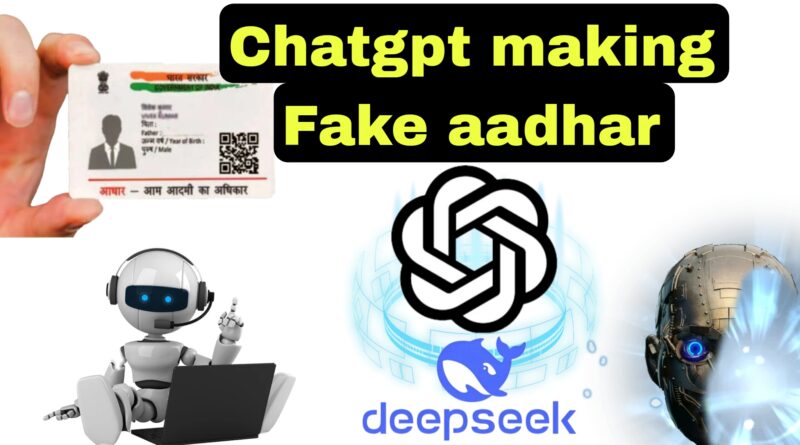Can ChatGPT Create Fake Aadhaar and PAN Cards in 2025? AI’s Rising Threat to Identity Security
Table of Contents
Can ChatGPT Create Fake Aadhaar
Over the last few weeks, ChatGPT has amazed the internet with its creative capabilities, from generating poetic stories to mimicking art styles. But as the popularity of generative AI grows, so do the concerns about its misuse. One such concern is the creation of fake identity documents like Aadhaar cards and PAN cards using tools like ChatGPT.
This article explores whether ChatGPT and similar AI models can actually generate fake government documents, the risks this poses to individuals and systems, and how to safeguard against such threats.
AI and the Creation of Fake Government IDs
It might sound like something out of a sci-fi movie, but people have already started using AI tools to generate images of fake Aadhaar and PAN cards. These fake documents often include fictional names, fake ID numbers, and computer-generated photos that closely resemble real IDs at a glance.

On platforms like X (formerly Twitter), Instagram, and Reddit, fake Aadhaar cards showing names like “Elon Musk” or “Cristiano Ronaldo” have gone viral. While many users are posting these images as memes, the underlying technology is capable of more deceptive use.
ChatGPT itself does not directly create images, but it can provide structured templates or text that can be used to mimic the layout of a government-issued card. Paired with image-generation AI tools like DALL·E or open-source models, these texts can be turned into visuals that look authentic to the untrained eye.
What Happens When You Ask ChatGPT to Make a Fake ID?
If you try asking ChatGPT to create a fake ID, it usually responds by denying the request. OpenAI, the company behind ChatGPT, has strict policies that prohibit illegal or deceptive use. But there are ways that some users have manipulated prompts to get around these rules.
For instance, when asked to generate a “sample PAN card for educational purposes,” some versions of ChatGPT have provided generic-looking templates. Even though the card may say “sample” on it, the level of realism it achieves is concerning. Combine that with a fake photo and plausible address, and you have a document that can deceive someone unaware.
Imagine a small business owner in a remote town hiring someone based on a printed ID. Without tools to verify authenticity, they could fall victim to fraud.
Why Is This a Big Deal?
The real threat here isn’t just the card – it’s the trust it abuses. Fake IDs aren’t new, but AI has made creating them significantly easier. Earlier, creating realistic documents required design skills, image editing software, and time. Now, a few well-phrased prompts are enough.
What makes the issue worse is the scale. Generative AI is now accessible to millions of people globally. Many open-source AI models do not have the restrictions that tools like ChatGPT have. This means anyone with minimal knowledge can create fake IDs with little oversight or accountability.
Beyond fraud, this also poses national security risks. Misuse of fake IDs can lead to illegal financial transactions, false employment, or even identity theft. When the cost of deception is reduced to a few clicks, the threat becomes very real.
What About Legal and Technical Safeguards?
Fortunately, many systems – especially in India – have multiple verification layers. Biometric authentication, QR code scanning, and API integrations with government databases help filter out fake identities during official Know Your Customer (KYC) processes.
However, offline and manual verification remains vulnerable. Landlords, small businesses, or even temporary employers might rely solely on physical copies of identity documents, and that’s where the risk remains highest.
Tech companies are also investing in content detection tools that can identify AI-generated content. However, such tools are still developing and not foolproof.
How Can You Stay Safe?
- Always cross-check identity documents using official government portals.
- Be cautious of IDs that look perfect but have minor inconsistencies in fonts or layout.
- If you’re an employer, use e-KYC whenever possible.
- Stay updated on the latest AI tools and their capabilities to avoid falling for digital fraud.
Conclusion: AI Is Powerful – Use It Responsibly
The emergence of AI tools like ChatGPT brings with it both opportunity and risk. While they can enhance creativity, learning, and productivity, they can also be used maliciously if not handled responsibly.
Creating fake Aadhaar or PAN cards might seem like a prank to some, but it reflects a deeper issue – our growing reliance on digital identities and how easily they can be manipulated. It’s crucial for users, platforms, and governments to work together in building awareness, strengthening regulations, and promoting ethical use of AI.
Was this article helpful? Stay informed about AI safety and digital fraud. Join our tech alert newsletter to get the latest updates straight to your inbox!
-
PM Narendra Modi Inaugurates India’s First Vertical Lift Sea Bridge in 2025: A Historic Gift to Rameswaram
Published On: April 6, 2025Author: [Rajesh kumar] Highlights: A Historic Gift for Rameswaram on Ram Navami On the auspicious occasion
-
Can ChatGPT Create Fake Aadhaar and PAN Cards in 2025? AI’s Rising Threat to Identity Security
Can ChatGPT Create Fake Aadhaar Over the last few weeks, ChatGPT has amazed the internet with its creative capabilities, from
-
How to Buy Nintendo Switch 2 in 2025 – Best Deals, Pros & Cons Revealed
Nintendo Switch 2 Nintendo Switch 2 has become one of the most trending gaming devices of 2025. Nintendo has provided users
-
What Happened to Val Kilmer in 2025 ? A Story of Resilience, Struggles, and Comeback
Val Kilmer: The Story of a Struggling Actor Early Life and Career Beginnings You know, when someone’s career shines, we
-
Cesar Chavez Day 2025: Why Millions Passionately Celebrate It, But the U.S. Government Doesn’t?
✴️Introduction Cesar Chavez Day is celebrated every year on March 31. This day is celebrated to honor the birth anniversary
-
Shogun Richard Chamberlain: Legendary Actor Passes Away at 90
Shogun Richard Chamberlain : Richard Chamberlain was a famous American actor who played the lead role in the 1980 mini-series
-
Tesla Tiny House 2025: A Game-Changer in Affordable and Sustainable Living
Intro Elon Musk and Tesla have once again amazed the tech world with an innovation that promises to revolutionize the









Leave a Reply